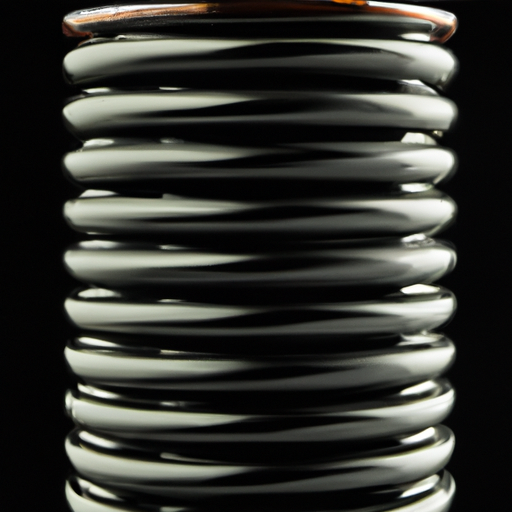Latest coil specifications
Latest Coil Specifications: A Comprehensive Guide
I. Introduction
Coils are integral components in a wide array of industries, serving various functions from energy storage to mechanical support. Whether in electrical engineering, HVAC systems, or automotive applications, understanding coil specifications is crucial for manufacturers and engineers alike. This blog post aims to provide a detailed overview of the latest coil specifications, exploring different types of coils, their key specifications, industry standards, recent innovations, and applications.
II. Types of Coils
A. Electrical Coils
Electrical coils are primarily used in circuits to store energy in the form of a magnetic field. Two common types of electrical coils are inductors and transformers.
1. **Inductors**: These coils resist changes in electrical current, making them essential in filtering applications and energy storage.
2. **Transformers**: Transformers transfer electrical energy between circuits through electromagnetic induction, playing a vital role in power distribution.
B. HVAC Coils
In heating, ventilation, and air conditioning (HVAC) systems, coils are crucial for heat exchange.
1. **Chilled Water Coils**: These coils cool air by circulating chilled water, essential for air conditioning systems.
2. **Hot Water Coils**: Conversely, hot water coils heat air, providing warmth in colder climates.
C. Spring Coils
Spring coils are mechanical devices that store energy when deformed and release it when returning to their original shape.
1. **Compression Springs**: These springs compress under load and are widely used in various applications, from automotive to consumer products.
2. **Tension Springs**: Tension springs are designed to stretch and are commonly found in mechanisms requiring pulling force.
D. Specialty Coils
Specialty coils are custom-designed for specific applications, often incorporating emerging technologies.
1. **Custom Coils**: Tailored to meet unique requirements, these coils can be designed for specific electrical or mechanical properties.
2. **Emerging Technologies**: Innovations in coil design, such as 3D printing and advanced materials, are paving the way for more efficient and effective coils.
III. Key Specifications for Coils
Understanding the specifications of coils is essential for ensuring optimal performance and reliability.
A. Material Composition
The choice of material significantly impacts a coil's performance.
1. **Common Materials**: Coils are typically made from copper, aluminum, or steel. Copper is favored for its excellent electrical conductivity, while aluminum is lighter and more cost-effective.
2. **Impact of Material Choice**: The material affects not only the coil's electrical properties but also its thermal and mechanical characteristics.
B. Dimensions and Tolerances
Coil dimensions and tolerances are critical for ensuring compatibility and performance.
1. **Standard Sizes**: Many coils come in standard sizes, but custom dimensions are often required for specific applications.
2. **Importance of Tolerances**: Tight tolerances are essential in manufacturing to ensure that coils fit correctly and function as intended.
C. Electrical Specifications
Electrical specifications define how a coil will perform in a circuit.
1. **Resistance, Inductance, and Capacitance Values**: These parameters determine how a coil interacts with electrical signals.
2. **Voltage and Current Ratings**: Understanding the maximum voltage and current a coil can handle is crucial for preventing failures.
D. Thermal Specifications
Thermal specifications are vital for ensuring that coils operate within safe temperature ranges.
1. **Operating Temperature Ranges**: Coils must be designed to function effectively within specified temperature limits.
2. **Heat Dissipation Characteristics**: Effective heat dissipation is necessary to prevent overheating and ensure longevity.
E. Mechanical Specifications
Mechanical specifications address the physical properties of coils.
1. **Load Capacity and Fatigue Limits**: Understanding the load a coil can bear and its fatigue limits is essential for applications involving repeated stress.
2. **Corrosion Resistance and Environmental Considerations**: Coils must be designed to withstand environmental factors, including humidity and corrosive substances.
IV. Industry Standards and Certifications
Adhering to industry standards is crucial for ensuring safety and performance.
A. Overview of Relevant Standards
Organizations such as ISO and ASTM provide guidelines and standards for coil manufacturing.
B. Importance of Compliance
Compliance with these standards ensures that coils meet safety and performance requirements, reducing the risk of failures.
C. Certification Processes
Certification processes validate that coils meet specific standards, providing assurance to manufacturers and consumers alike.
V. Recent Innovations in Coil Technology
The coil industry is witnessing significant innovations that enhance performance and sustainability.
A. Advances in Materials and Manufacturing Techniques
New materials, such as high-temperature superconductors, and advanced manufacturing techniques, like additive manufacturing, are revolutionizing coil design.
B. Smart Coils and Their Applications in IoT
The integration of smart technology into coils allows for real-time monitoring and control, enhancing their functionality in Internet of Things (IoT) applications.
C. Sustainability Trends in Coil Production
Sustainability is becoming increasingly important, with manufacturers focusing on eco-friendly materials and processes to reduce environmental impact.
VI. Applications of Coils
Coils find applications across various industries, each with unique requirements.
A. Electrical and Electronic Devices
In electronics, coils are used in power supplies, filters, and signal processing.
B. HVAC Systems
Coils are essential for efficient heating and cooling in residential and commercial buildings.
C. Automotive Industry
In vehicles, coils are used in ignition systems, sensors, and various electronic components.
D. Aerospace and Defense
Coils play a critical role in aerospace applications, including navigation systems and communication devices.
E. Medical Devices
In the medical field, coils are used in imaging equipment and therapeutic devices, where precision and reliability are paramount.
VII. Conclusion
Understanding coil specifications is essential for anyone involved in manufacturing or engineering. As technology advances, the importance of staying updated on the latest specifications and innovations cannot be overstated. The future of coil technology promises exciting developments, from smart coils to sustainable production practices. Continuous education and adaptation will be key for professionals in the industry to remain competitive and effective.
VIII. References
For further reading on coil specifications and industry standards, consider exploring the following resources:
- International Organization for Standardization (ISO)
- American Society for Testing and Materials (ASTM)
- Industry publications on electrical engineering and HVAC systems
By staying informed and engaged with the latest developments in coil technology, professionals can ensure they are well-equipped to meet the challenges of an ever-evolving industry.
